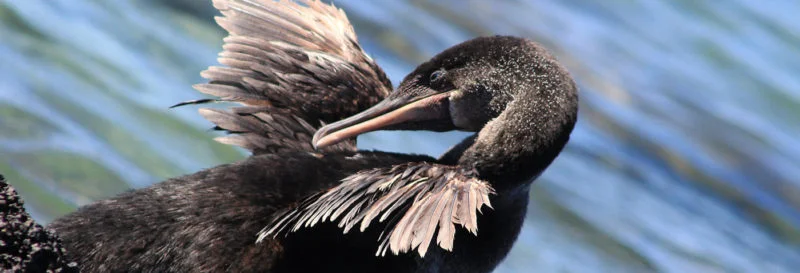
Why do not cormorants fly in the Galapagos? | Travel Blog
The flightless cormorant, often known as the Galapagos cormorant because it is the only species found on the islands, is a truly remarkable bird. Current numbers stand at around 700 to 800 breeding pairs, making them quite a rare species and popular with anyone wanting to cruise the Galapagos Islands.
However, one thing makes them stand out even more and that’s the fact that it is the only cormorant species that can’t fly. These heavy birds have lost their ability to fly over time, and one look at the small and inadequate wings tells you why.
Their wings, however, are not simply for show and are crucial for balance as they jump from rock to rock. But how have they been able to survive given the fact they can’t fly, we hear you ask? Well, in losing the power of flight they have gained some significant other skills. As another indicator of Darwinian evolution, it was the birds who could dive here who thrived, meaning the genes for flight and strong wings were gradually bred out of these birds.
Their heavier size and webbed feet allow them to dive beneath the surface, and their long necks allow them to skewer their pray, which includes eel and octopus. They adapted so well to swimming that they no longer needed to fly to survive.
Their heavier size and webbed feet allow them to dive beneath the surface, and their long necks allow them to skewer their pray, which includes eel and octopus. They adapted so well to swimming that they no longer needed to fly to survive.
Although there is another theory, which states that due to the absence of natural predators on the Galapagos Islands, the birds became lazier and simply lost their ability to fly over time. However, evolution tends to favor more positive developments rather than negative ones.
Whatever the reasons for their unique stature, the birds are a very popular attraction for anyone wanting to cruise the Galapagos Islands. They are mostly found on the westerly coast of Fernandina and Isabela islands, which are common stopping off points when you cruise the Galapagos Islands. Look at a Galapagos map if you want to know the exact location of these islands in the archipelago or ask your skipper to take you there.
Along with the blue-footed boobies, marine iguanas and turtle species, the flightless cormorant forms another part of the unique wildlife that evolved on these isolated islands. Anyone lucky enough to cruise the Galapagos Islands gets the chance to see these truly special animals in the wild. A rare treat indeed.
Take a look of these tour programs:
1. Galapagos & Machu Picchu Tour: Galapagos & Machu Picchu 12 Days Voyage
2. Cusco Tour: Cusco and Sacred Valley Tour
3. Amazon River Cuise in Ecuador: Amazon River Cruise Journey
4. Galapagos Cruise Itinerary: Amazing Nine Days East & Central Islands Boat Journey
5. Inca Trails Tour: The Incas Trail Tour
Check Our Suggested Tours:
- Deluxe Center Island Cruise Large Ship Journey
- Western & Southern Majesty of Galapagos 8-Day Cruise
- Galapagos Southern Islands 6 days cruise Itinerary on board Ocean Spray
- The Charm of the Western Islands Yacht Venture
- Short and luxurious Galapagos islands cruise Elite catamaran 4 day Southeastern route
- Galapagos Isles Eastern Voyage 8-Day Relais Chateaux Luxury Cruise
Check Our Galapagos Cruises:

